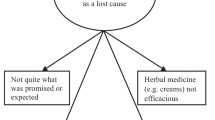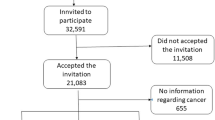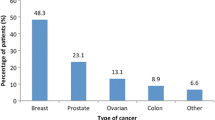Abstract
The use of complementary and alternative medicine (CAM) has been rapidly increasing among cancer patients. The aim of this study is to evaluate the prevalence and patterns of CAM use, particularly patients' intentions and their perceived effectiveness of using Chinese herbal medicine (CHM), as well as the relations between the herbal medicine use and demographic and clinical factors among Chinese women with breast cancer. We analyzed the data from a population-based sample of 1065 breast cancer women in urban Shanghai. Patients' average age at diagnosis was 48.1 years and the median time from the initial diagnosis to the follow-up survey was 4.3 years. Overall, 98% of patients had used at least one form of CAM therapy after diagnosis of breast cancer. The most popular CAM modality was traditional Chinese medicine (86.7%), followed by the use of supplements (84.8%), physical exercises (65.5%), and support group attendance (16.6%). CHM was used by 86.4% of patients, while acupuncture was used only by 4.9% of patients. Treating cancer (81.5%) was the most common intentions of using CHM. Other cited intentions included enhancing the immune system (12%), preventing metastasis of cancer or managing other discomforts (7.9%), and lessening menopausal symptoms (4.7%). The majority of patients reported that they had benefited from the use of CHM. Patients who were younger, married, had higher education or income, received chemotherapy or radiotherapy, or had recurrence/metastasis of cancer tended to use CHM more frequently than other patients. The relations between patient characteristics and use of CHMs varied with users' intentions. Given the high prevalence of CAM use among breast cancer patients, research is urgently needed to systematically evaluate the efficacy and safety of CAM use, particularly use of herbal medicines.
Similar content being viewed by others
References
National Center for Complementary and Alternative Medicine: What is complementary and alternative medicine. Available from http://nccam.nih.gov/health/whatiscam. Accessed 9 January 2004
Cassileth BR, Schraub S, Robinson E, Vickers A: Alternative medicine use worldwide: the International Union Against Cancer Survey. Cancer 91: 1390–1393, 2001
The prevalence of complementary/alternative medicine in cancer: a systematic review. Cancer 83: 777-782, 1998
Fernandez C, Pyesmany A, Stutzer C: Alternative therapies in childhood cancer. N Engl J Med 340: 569–570, 1999
Burstein HJ, Gelber S, Guadagnoli E, Weeks JC: Use of alternative medicine by women with early-stage breast cancer. N Engl J Med 340: 1733–1739, 1999
DiGianni LM, Garber JE, Winer EP: Complementary and alternative medicine use among women with breast cancer. J Clin Oncol 20: 34S–38S, 2002
Risberg T, Lund E, Wist E, Kaasa S, Wilsgaard T: Cancer patients use of nonproven therapy: a 5-year follow-up study. J Clin Oncol 16: 6–12, 1998
Morris KT, Johnson N, Homer L, Walts D: A comparison of complementary therapy use between breast cancer patients and patients with other primary tumor sites. Am J Surg 179: 407–411, 2000
Kraut AM: Healers and strangers. Immigrant attitudes toward the physician in America-a relationship in historical perspective. JAMA 263: 1807–1811, 1990
Lee MM, Lin SS, Wrensch MR, Adler SR, Eisenberg D: Alternative therapies used by women with breast cancer in four ethnic populations. J Natl Cancer Inst 92: 42–47, 2000
Tagliaferri M, Cohen I, Tripathy D: Complementary and alternative medicine in early-stage breast cancer. Semin Oncol 28: 121–134, 2001
Cohen I, Tagliaferri M, Tripathy D: Traditional Chinese medicine in the treatment of breast cancer. Semin Oncol 29: 563–574, 2002
Ernst E: Toxic heavy metals and undeclared drugs in Asian herbal medicines. Trends Pharmacol Sci 23: 136–139, 2002
Markman M: Safety issues in using complementary and alternative medicine. J Clin Oncol 20: 39S–41S, 2002
Parkin DM: Global cancer statistics in the year 2000. Lancet Oncol 2: 533–543, 2001
Boon H, Stewart M, Kennard MA, Gray R, Sawka C, Brown JB, McWilliam C, Gavin A, Baron RA, Aaron D, Haines-Kamka T: Use of complementary/alternative medicine by breast cancer survivors in Ontario: prevalence and perceptions. J Clin Oncol 18: 2515–2521, 2000
Richardson MA, Sanders T, Palmer JL, Greisinger A, Singletary SE: Complementary/alternative medicine use in a comprehensive cancer center and the implications for oncology. J Clin Oncol 18: 2505–2514, 2000
Rees RW, Feigel I, Vickers A, Zollman C, McGurk R, Smith C: Prevalence of complementary therapy use by women with breast cancer. A population-based survey. Eur J Cancer 36: 1359–1364, 2000
Ma GX: Between two worlds: the use of traditional and Western health services by Chinese immigrants. J Community Health 24: 421–437, 1999
Zhang J, Verhoef MJ: Illness management strategies among Chinese immigrants living with arthritis. Soc Sci Med 55: 1795–1802, 2002
Gao YT, Shu XO, Dai Q, Potter JD, Brinton LA, Wen W, Sellers TA, Kushi LH, Ruan Z, Bostick RM, Jin F, Zheng W: Association of menstrual and reproductive factors with breast cancer risk: results from the Shanghai Breast Cancer Study. Int J Cancer 87: 295–300, 2000
Shu XO, Jin F, Dai Q, Shi JR, Potter JD, Brinton LA, Hebert JR, Ruan Z, Gao YT, Zheng W: Association of body size and fat distribution with risk of breast cancer among Chinese women. Int J Cancer 94: 449–455, 2001
Ashikaga T, Bosompra K, O'Brien P, Nelson L: Use of complimentary and alternative medicine by breast cancer patients: prevalence, patterns and communication with physicians. Support Care Cancer 10: 542–548, 2002
Cassileth BR, Lusk EJ, Strouse TB, Bodenheimer BJ: Contemporary unorthodox treatments in cancer medicine. A study of patients, treatments, and practitioners. Ann Intern Med 101: 105–112, 1984
McGinnis LS: Alternative therapies, 1990. An overview. Cancer 67: 1788–1792, 1991
Gertz MA, Bauer BA: Caring (really) for patients who use alternative therapies for cancer. J Clin Oncol 19: 4346–4348, 2001
Salmenpera L: The use of complementary therapies among breast and prostate cancer patients in Finland. Eur J Cancer Care 11: 44–50, 2002
Sollner W, Maislinger S, DeVries A, Steixner E, Rumpold G, Lukas P: Use of complementary and alternative medicine by cancer patients is not associated with perceived distress or poor compliance with standard treatment but with active coping behavior: a survey. Cancer 89: 873–880, 2000
Penson RT, Castro CM, Seiden MV, Chabner BA, Lynch Jr TJ: Complementary, alternative, integrative, or unconventional medicine? Oncologist 6: 463–473, 2001
Eisenberg DM, Davis RB, Ettner SL, Appel S, Wilkey S, Van Rompay M, Kessler RC: Trends in alternative medicine use in the United States, dy1990-1997: results of a follow-up national survey. JAMA280: 1569–1575, 1998
Downer SM, Cody MM, McCluskey P, Wilson PD, Arnott SJ, Lister TA: Pursuit and practice of complementary therapies by cancer patients receiving conventional treatment. BMJ 309: 86–89, 1994
Paltiel O, Avitzour M, Peretz T, Cherny N, Kaduri L, Pfeffer RM, Wagner N, Soskolne V: Determinants of the use of complementary therapies by patients with cancer. J Clin Oncol 19: 2439–2448, 2001
Author information
Authors and Affiliations
Corresponding author
Additional information
An erratum to this article is available at http://dx.doi.org/10.1023/B:BREA.0000032990.90079.74.
Rights and permissions
About this article
Cite this article
Cui, Y., Shu, XO., Gao, Y. et al. Use of complementary and alternative medicine by Chinese women with breast cancer. Breast Cancer Res Treat 85, 263–270 (2004). https://doi.org/10.1023/B:BREA.0000025422.26148.8d
Issue Date:
DOI: https://doi.org/10.1023/B:BREA.0000025422.26148.8d




